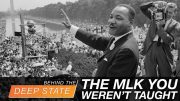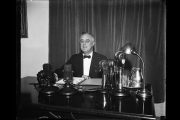Among the files related to the JFK assassination that were recently released was an FBI research paper dated March 12, 1968, with the subject line “Martin Luther King, Jr.: A Current Analysis.” The paper was written just a month before the controversial civil-rights activist was shot and killed on April 4, 1968. King’s convicted killer, James Earl Ray, pled guilty to his murder, received a life sentence, and died in prison of natural causes 29 years later.
The 20-page paper, which was classified as “secret,” was reviewed by the FBI/JFK Task Force in 1994, which denied the release of its contents.
The introduction to the paper observed that since 1956, King had “occupied a prominent role in the drive for equal rights for Negroes in the Untied States.” It continued by noting, “The course King chooses to follow at this critical time could have momentous impact on the future of race relations in the United States, and for that reason this paper has been prepared to give some insight into the nature of the man himself as well as the nature of his views, goals, objective, tactics, and the reason therefore.”
The paper’s summary of King’s planned Washington Spring project is contrary to the image of King painted by most historians as a man who employed only the most peaceful means. The project, while stopping short of violent riots, nevertheless advocated widespread “civil disobedience” (a nonviolent, but nevertheless illegal activity) that King said he and 3,000 of his followers planned on staging in Washington that spring. The paper stated that King had announced that this action would disrupt the normal course of business and, in fact, close down the nation’s capital. The paper quotes“ King’s statement explaining his strategy: To dislocate the function of a city without destroying it can be more effective than a riot, because it can be longer lasting, costly to society, and not wantonly destructive.”
King’s admission that the strategy he planned for Washington, D.C, would be “costly to society” is startling in view of a fact noted in The Urban Institute report, “Our Changing City,” which observed: “1950 also marked the start of the white exodus to the suburbs. In only two decades, the white population fell by over 300,000; DC became majority-black in the late 1950s.”
Therefore, ironically, the “society” that King intended to bear the cost for his civil disobedience was to be a black society.
As the paper continued, it provided documentation that what King planned for after the civil disobedience would not be so innocuous. It stated that King had allied himself with black nationalist groups that planned to “seize the initiative and escalate the nonviolent demonstrations into violence.” It continued:
King has met with black nationalists and attempted to solicit their support. Stokely Carmichael of the Student Nonviolent Coordinating Committee (SNCC), an extremist Black Nationalist organization, has conferred with King…. King is aware of the possibility of violence because one of his aides proclaimed recently to the press, “Jail will be the safest place in Washington this spring.”
However, the assessment of King got even worse. The next section of the FBI paper was subheaded “Strong Communist Influence.” It pulled no punches in stating:
Another complicating factor in the picture is the degree of communist influence on King. One of King’s principal advisors is Stanley David Levison. Ostensibly only a New York City attorney and businessman, Levison is, in fact, a shrewd, dedicated communist. Levison has spent the major part of his life advancing communist interests.
The paper then listed some of the ways Levison had supported and influenced King, as far back as 1956:
• He actively involved himself in fundraising drives for King.
• He served as King’s legal counsel.
• He suggested speech material for King.
• He guided King in deciding whether to accept or reject public appearances.
• He edited most of the chapter’s of King’s book Where Do We Go From Here: Chaos or Community?
The FBI paper then named another communist whose name is very familiar to those who have read articles about King’s communist connections in The New American, its predecessor magazine, American Opinion, and the monthly bulletins of The John Birch Society, the parent organization of both publications. Further information about this communist was found in the book, It’s Very Simple: The True Story of Civil Rights, by the late author and speaker Alan Stang. As the paper notes:
Through Levison’s influence, other subversives were attracted to SCLC [The Southern Christian Leadership Conference, which King helped found]. Hunter Pitts O’Dell, former National Committee member of the CPUSA, was employed by SCLC. In 1962, when King mentioned to Levinson that he was thinking of adding an administrative assistant to his staff, Levinson recommended O’Dell, who was then head of SCLC’s New York office. King said he liked the idea. At that time, King was well aware of Levison’s and O’Dell’s communist affiliations.
Under the sub-head “Communist Exposed,” the paper went on to reveal more about O’Dell:
King was forced to get rid of Hunter Pitts O’Dell in October, 1962, when several newspaper articles exposed O’Dell’s connection with SCLC and his communist affiliations. King still tried to hide O’Dell in his organization until July, 1963, when he accepted O’Dell’s “resignation.” As King put it, O’Dell’s release was not because of connections between O’Dell and the CPUSA but because of the emotional public response.
In an article in The New American back in 1999, John F. McManus, former publisher of this magazine and president emeritus of The John Birch Society, provided further detail about O’Dell association with King:
In 1960, King hired one Hunter Pitts O’Dell to his staff. When O’Dell’s position as a member of the National Committee of the Communist Party was revealed in 1961, King supposedly fired him. But it turned out that rather than discharging this key Red, he had transferred and promoted O’Dell to a higher post within King’s Southern Christian Leadership Conference. When O’Dell was again exposed, King went through the same routine of announcing his dismissal. But a check by United Press International found him still employed by King’s organization.
As an indication of just how much Robert Welch, the Founder of The John Birch Society, was on top of King’s communist connection, he wrote the following words for May 1968 John Birch Society Bulletin — just two months after the FBI report, which had been classified as secret:
During this career of a brief dozen years, [King] was constantly surrounded by, and associated with, Communists. He “employed” such Communists as Bayard Rustin and Hunter Pitts O’Dell; and he worked closely with Carl Braden and James Dumbrowski.
As for how Welch was able to gather such damning information about King when the FBI files on the activist were classified, much has to do with the fact that there were many patriotic members of the FBI and other agencies who recognized that Welch and the society he founded constituted a trustworthy place to reveal what they knew. As one example, Dan Smoot, a former FBI agent, was a steadfast anti-Communist who became associated with The John Birch Society and wrote for the society’s American Opinion and The Review Of The News magazines.
Julia Brown, author of I Testify: My Years as an F.B.I. Undercover Agent, was an undercover agent for the FBI in the Cleveland area. She told a congressional subcommittee that while she was a member of the Communist Party, she “knew Martin Luther King to be closely connected with the Communist Party.” Brown joined The American Opinion Speakers Bureau, and while on the lecture circuit, she told audiences that King “was the hero of America’s Communists. The cells that I was associated with in Cleveland were continually being asked to raise funds for Martin Luther King’s activities.” She also said, “Mr. King was one of the worst enemies my people ever had.” Her reference to “my people” was to her race, since she was black.
When The John Birch Society first made King’s communist connections known almost 50 years ago, most people were skeptical. After King’s violent death, and the sealing of most government files related to King, the natural tendency of people to not want to speak ill of the dead set in. When prominent people die violently, they become martyrs in some people’s eyes, and there is a reluctance on their part even to consider anything that blemishes the heroic image they have formed of the individual. They would rather ignore the facts than become disillusioned.
As President Ronal Reagan once wrote to former New Hampshire Governor Meldrim Thomson, who had sent a letter to Reagan urging the president not to sign the bill for a holiday honoring King, “On the national holiday you mentioned, I have the reservations you have, but here the perception of too many people is based on an image, not reality. Indeed, to them the perception is reality.” (Emphasis in original.)
With the release of this FBI document, however, it seems that the FBI and the JBS were on the same page regarding King. Whatever noble goals King proclaimed, the subversive company he chose to keep severely neutralizes any good he may have aspired to and creates serious doubts about the sincerity of his stated mission.
Related articles:
Declassified FBI Paper Reveals Martin Luther King’s “Sexual Aberrations”
Martin Luther King Day Based on MLK’s Image, Not Reality




